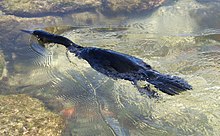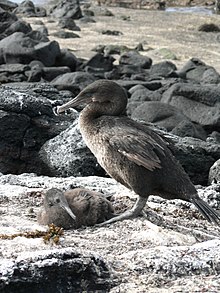Galapagos shard
| Galapagos shard | ||||||||
|---|---|---|---|---|---|---|---|---|

Galapagos shear ( Phalacrocorax harrisi ) |
||||||||
| Systematics | ||||||||
|
||||||||
| Scientific name | ||||||||
| Phalacrocorax harrisi | ||||||||
| Rothschild , 1898 |
The Cormorant ( Phalacrocorax harrisi ) even stub Cormorant called, is a bird art from the family of cormorants , on the Galapagos Islands lives. It is the only species of cormorant that has lost its ability to fly, and in the past it was even placed in its own genus Nannopterum . Today the assignment to the genus Phalacrocorax is common.
Physique, appearance
When fully grown, cormorants reach a body length of around 89 to 100 cm and then weigh between 2.3 and 4 kg. With an average of 4 kg, the males are significantly heavier than the females, who weigh an average of 2.7 kg. This makes flightless cormorants about twice as heavy as their flightless relatives. Their wings, on the other hand, are about 18 cm shorter than those of all other cormorants. The blackish brown and fringed wings are only a third as large as a bird of this size would need to be able to fly. The sternum, to which the powerful muscles are attached in airworthy birds that are required for flight, is significantly smaller in this bird species. As with other cormorants, the feathers of the Galapagos shear are not water-repellent and the birds spend a lot of time drying their plumage in the sun after hunting.
Lifestyle and diet
Like the other cormorants, this bird has webbed feet and powerful legs that provide a powerful drive underwater. Its range of prey includes fish , eels and small squids . It looks for its prey near the sea floor and rarely more than 100 meters from the coast.
Evolution and threat
The Galapagos shear is one of the rarest sea birds . In 2004 only 1,500 individuals were counted. The Galapagos shag breeds in places where cold, oxygen-rich water rises to the surface with many animals that can serve as food. The low distribution and population size of the Galapagos Shear is likely a result of its adaptation to these waters, where food is always abundant. This also determines behavior and success in the brood.
The Galapagos shark developed its present-day appearance and behavior on an island that was free from predators . Since their food was located directly on the coast, this bird lost its ability to fly in the course of evolution . However, humans introduced a number of mammals such as cats , dogs and pigs that can be dangerous to the bird.
Courtship
The courtship of the cormorants begins with the animals swimming parallel to each other in the water, bending their necks so strongly in the shape of a snake that their beak touches the goiter (neck). They croak occasionally and from time to time one aligns and shakes. After 20 to 80 minutes, the male leads the female to the bank. On the bank, the male throws his head up so that the beak points to the sky and invites the female to come up. Then he bows deeply and points with the tip of the beak at the ground, while it often holds nest material in its beak and builds it into the nest wall.
Reproduction
Females can breed twice a year. They usually look for a new partner for each brood, as the female leaves the young earlier than the male. While only one young of the up to three eggs per clutch usually survives, once adult birds usually get very old. The population size is mainly limited by the limited availability of food, which puts the survival of the young at risk more than that of the parents. With this adaptation, the birds are very quickly able to recover from a decline in the population.
Web links
- Videos, photos and sound recordings of Phalacrocorax harrisi in the Internet Bird Collection
- Video: Heinz Sielmann: Nannopterum harrisi (Phalacrocoracidae) - brood separation . Institute for Scientific Film (IWF) 1964, made available by the Technical Information Library (TIB), doi : 10.3203 / IWF / E-596 .
Individual evidence
- ↑ a b c d e f g Nannopterum harrisi in the endangered Red List species the IUCN 2008. Posted by: BirdLife International, 2008. Accessed December 29 in 2009.
- ^ BC Livezey: Flightlessness in the Galapagos cormorant (Compsohalieus [Nannopterum] harrisi): Heterochrony, giantism and specialization. In: Zoological Journal of the Linnean Society. Vol. 105, no. 2, 1992, pp. 155-224.
- ↑ a b J. Bried, D. Pontier, P. Jouventin: Mate fidelity in monogamous birds: a re-examination of the Procellariiformes. In: Animal Behavior. Vol. 65, no. 1, Jan 2003, pp. 235-246.
- ^ A b Carlos A. Valle: Effective Population Size and Demography of the Rare Flightless Galapagos Cormorant. In: Ecological Applications. Vol. 5, No. 3, Aug 1995, pp. 601-617. doi: 10.2307 / 1941970 .
- ^ A b R. Tindle: The evolution of breeding strategies in the flightless cormorant (Nannopterum harrisi) of the Galapagos. In: Biological Journal of the Linnean Society. 1984.
- ↑ a b c Irenäus Eibl-Eibesfeldt: Galápagos. Noah's Ark in the Pacific. Piper, Munich / Zurich 1991, ISBN 3-492-11232-3 .
-
↑ Alejandro Burga et al .: A genetic signature of the evolution of loss of flight in the Galapagos cormorant. In: Science . Volume 356, No. 6341, 2017, eaal3345, doi: 10.1126 / science.aal3345
How the clumsy Galapagos cormorant lost its flight. On: sciencemag.org from June 1, 2017

